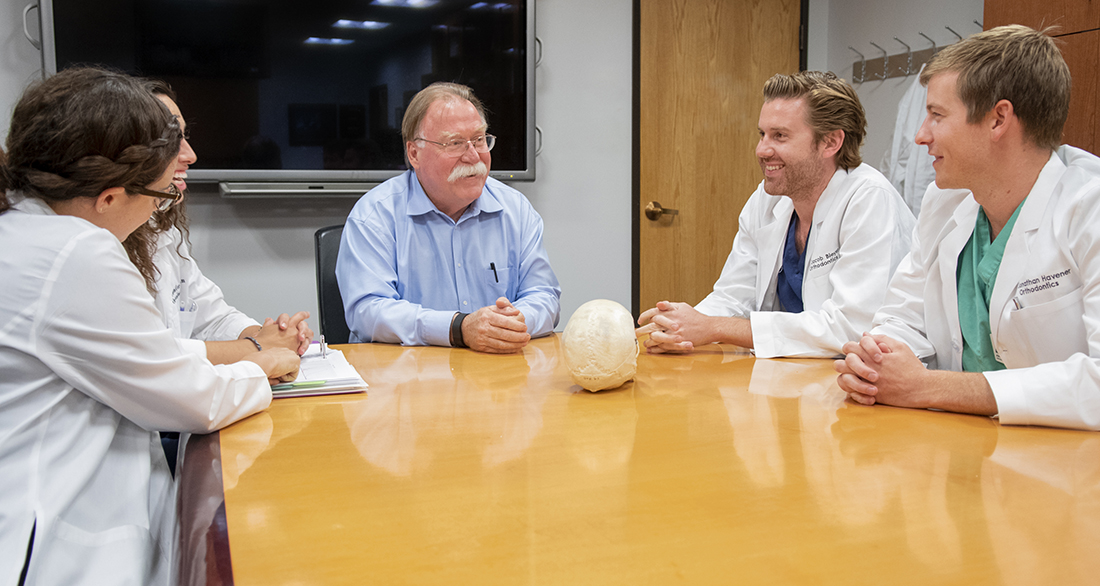The road less traveled

There was a time when Dr. Peter Buschang doubted his future in academic research. In fact, he considered getting out of academics entirely, had even applied to a couple MBA programs. It was 1983 and Buschang, then a postdoctoral fellow in the orthodontic department at the University of Connecticut dental school, was coming to the end of his three-year fellowship. He pursued faculty positions in anthropology departments, but hires were few and far between, and the husband and new father of two was considering a Plan B.
“At literally the last minute, I met Dr. Arto Demirjian, director of the Growth Center at the University of Montreal, who offered to support me for two years while I worked to get external funding,” says Buschang, Regents Professor and interim department head in orthodontics at Texas A&M College of Dentistry. He did indeed secure that funding, staying on for a total of five years with the school before being recruited to Dallas by then-department chair Dr. Richard Ceen, a new hire himself.
The concept — having a craniofacial researcher embedded within a clinical orthodontic program — was a recipe for success.
Thirty years, 305 refereed papers, 170 invited lectures, two books and 27 award-winning mentees later, Buschang has played a part in the program’s national prestige. Even more than $2.5 million in grant awards — a rarity for orthodontic programs — has supported the department’s research efforts.
The unique part of it all: Buschang’s career doesn’t hinge solely on his professional pursuits but, rather, on elevating the research of orthodontic graduate students through the decades.
This May, his body of work was lauded with a Lifetime Achievement Award from the American Association of Orthodontists.
“This award is the culmination of years of work by many individuals; it’s not just about me. Over the past 10 to 15 years, we have probably won more research awards and published more papers in refereed journals than any other orthodontic department in the U.S.,” says Buschang. “It means that the American Association of Orthodontists — the premiere association for orthodontists — recognizes that we are doing something special here at the college.”
Dr. Phillip Campbell retired from his role as orthodontic department head in September 2017, but that didn’t stop him from nominating Buschang for the award. “I knew there was a chance of him not receiving it, because he is not an orthodontist,” says Campbell. “But he is an awesome researcher. Not only has he contributed excellent orthodontic research in the past, he is on the cutting edge of current orthodontic research. He is not biased by things that sometimes we clinicians may be biased by. As a true scientist, he is a tremendous asset to the Department of Orthodontics and the College of Dentistry.”
During his 30 years at the College, Buschang has mentored more than 150 orthodontic graduate students and, as part of the Predoctoral Student Research Program, has worked with several dental students each summer. Dr. Tamara Jones ’11, now an orthodontist, was one of them. There’s one simple question he would pose that sticks with her to this day.
“He was always asking ‘why.’ ‘Why are we measuring these parameters? Why are we studying this and not that?’” says Jones. “My research summer developed my inquisitive nature that always has me asking ‘why’ in regard to my patients. ‘Why did this malocclusion develop? Why do we treat this case with extractions?’ Dr. Buschang’s greatest impact was to inspire me to always be researching, to never be satisfied with the status quo and to always be asking ‘why.’”
Dr. Maryam Mojdehi-Barnes ’97, ’99, a former part-time faculty member, maintains an orthodontic practice in Allen, Texas, and still remembers her first impression of Buschang in a growth and development course as a dental student.
“I remember being quite intimidated by him; he was the smartest person I’d ever met,” Mojdehi-Barnes recalls.
She worked with him later as an orthodontic graduate student at the college and shares a key takeaway: to question the validity of everything she learned and read.
“He taught me to only accept ideas that are evidence based and to start and end my research projects without an agenda. ‘Let the evidence and results guide you,’ he would say.
“Twenty-four years later, his integrity and unbiased enthusiasm are still my guiding light when it comes to continuing education and deciphering the body of research projects that are published,” adds Mojdehi-Barnes. “He is still the smartest person I know.”